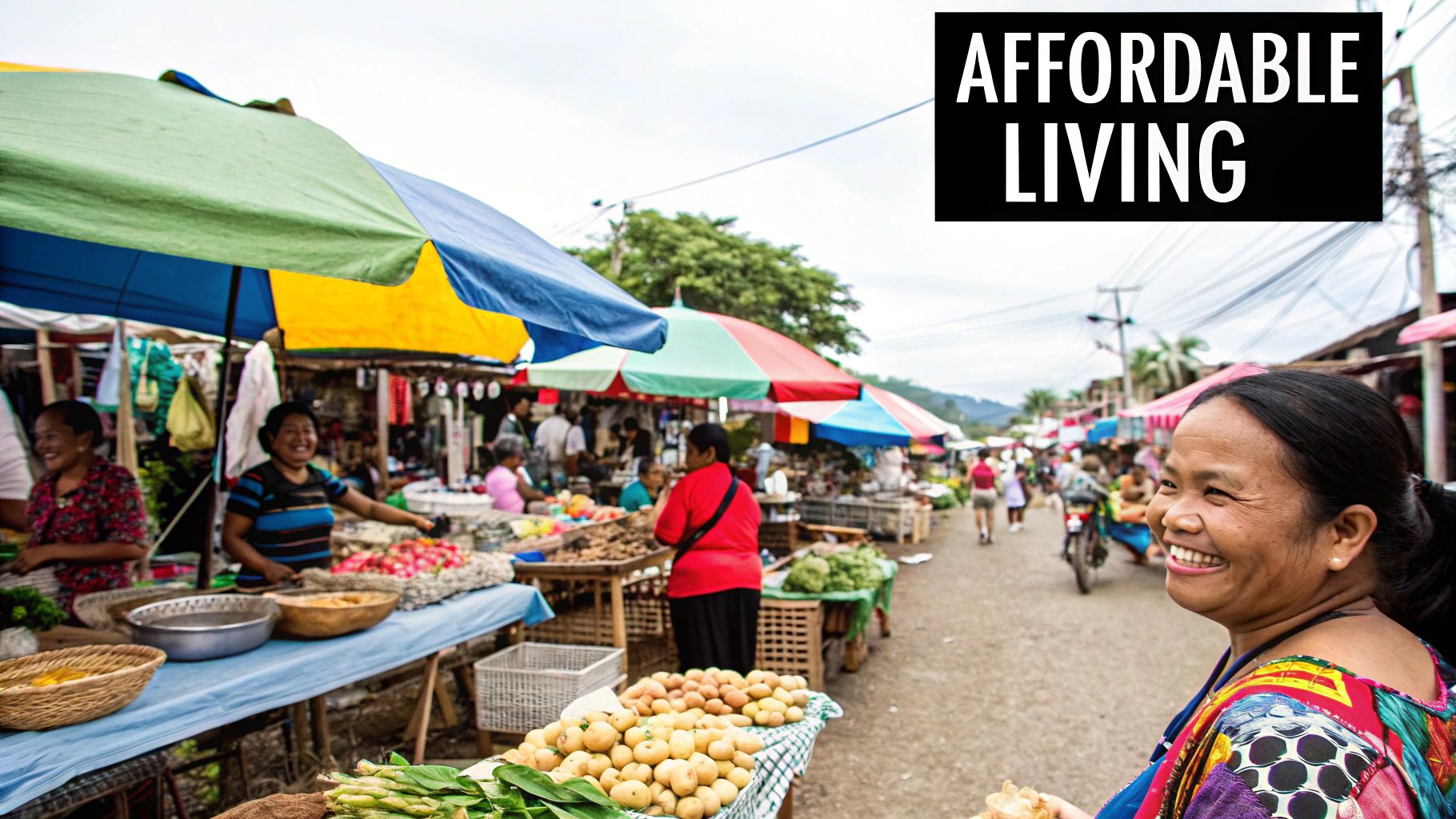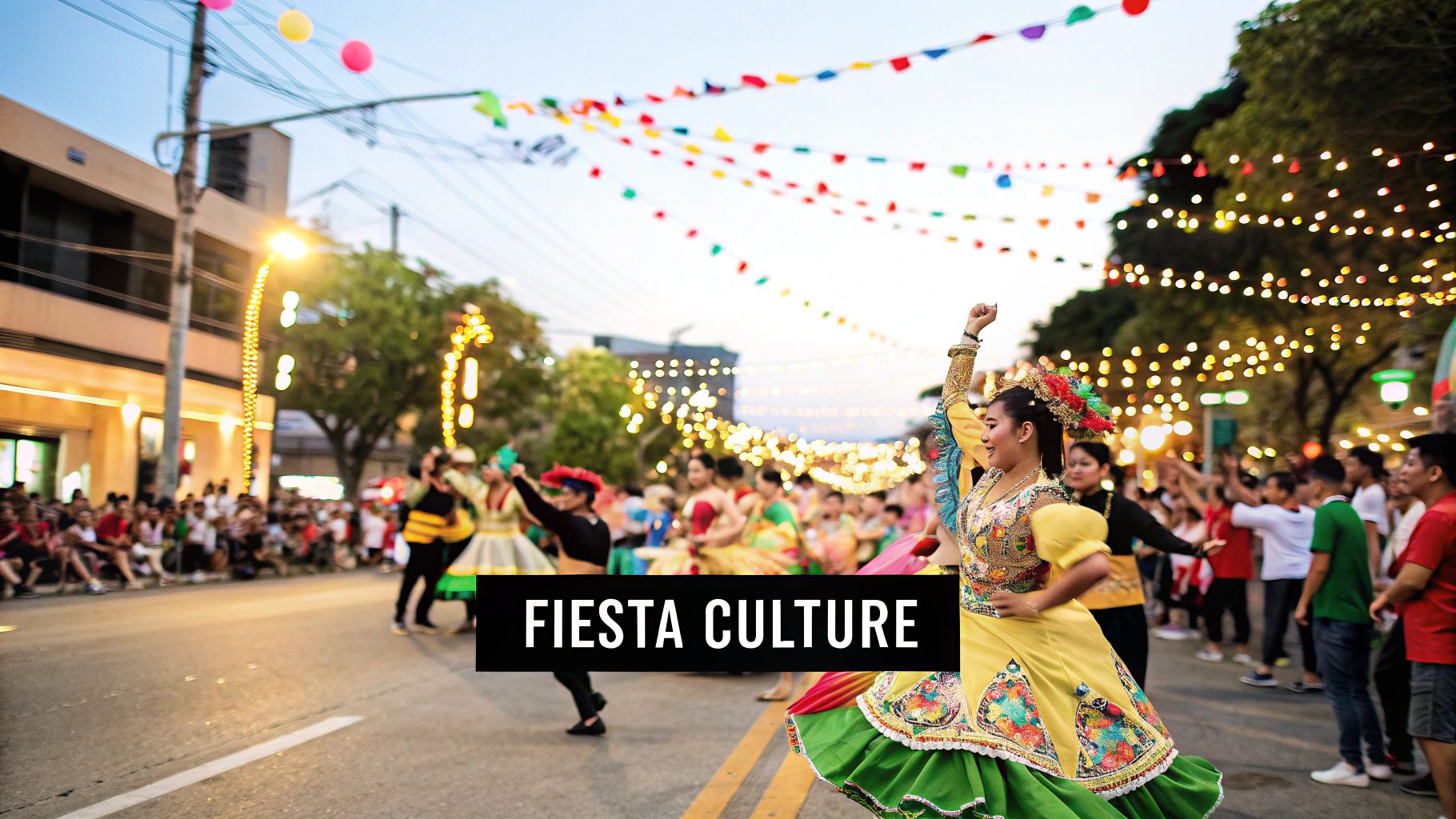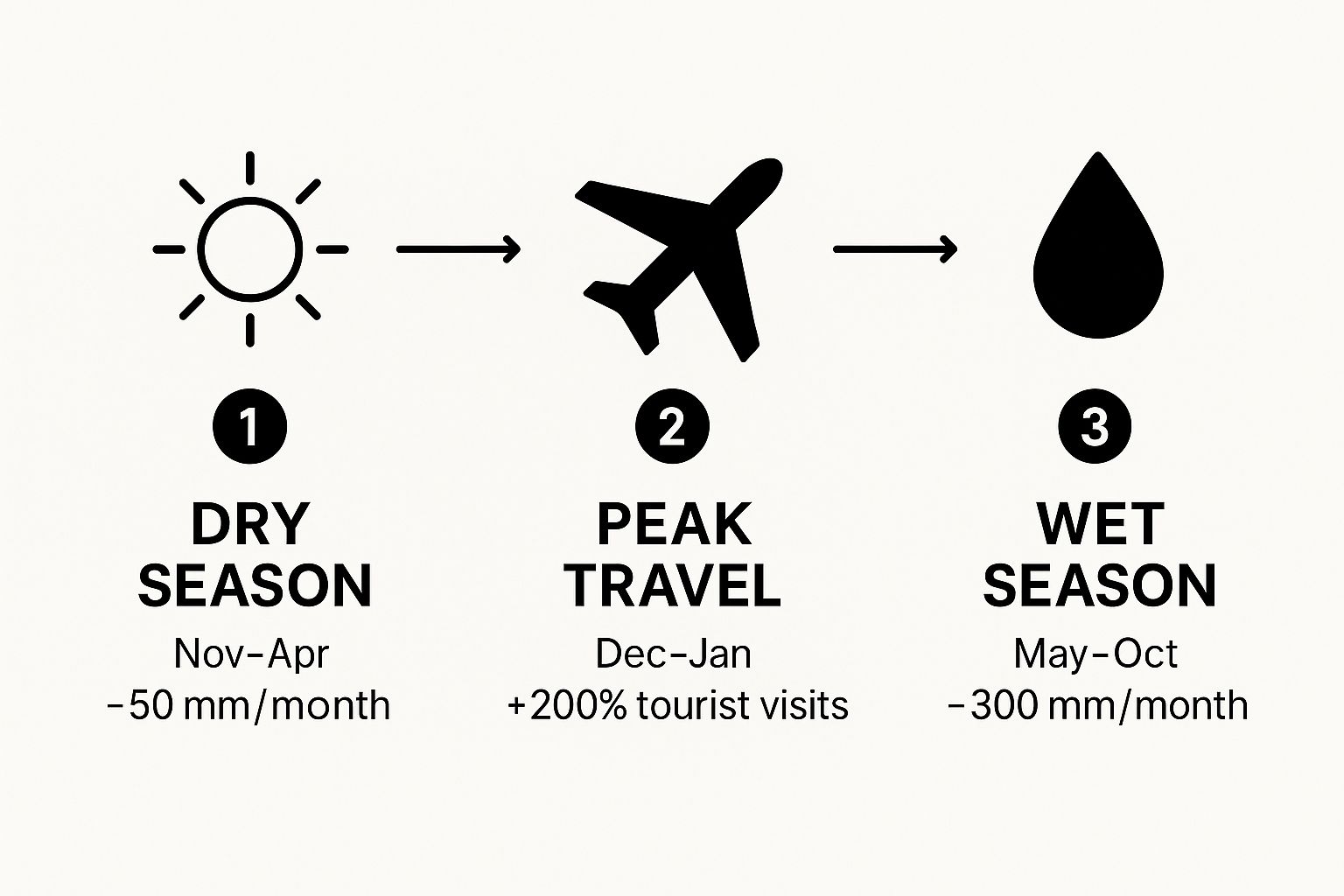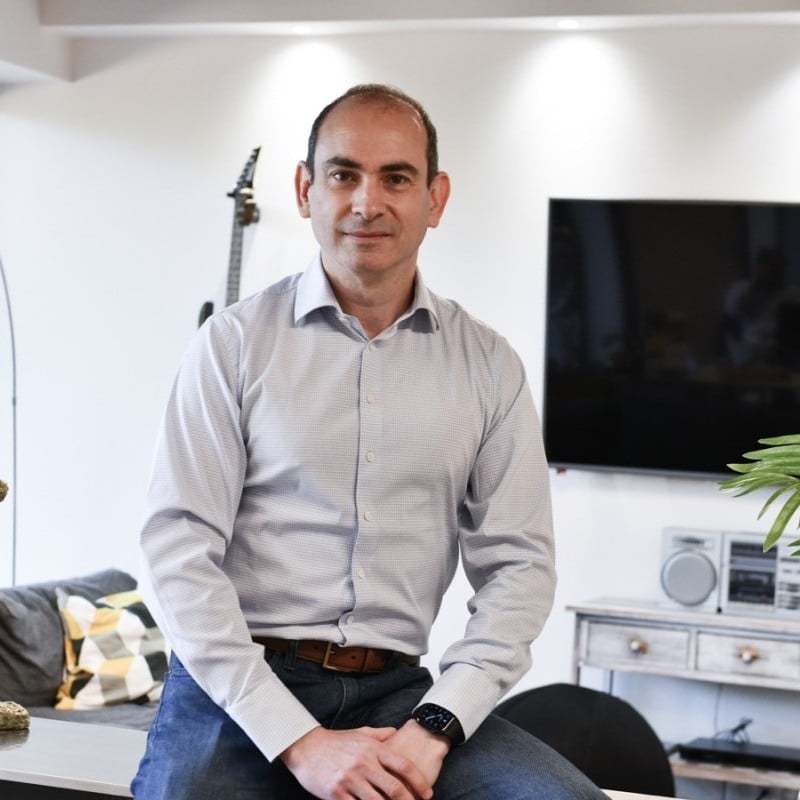Living in the Philippines is about more than just finding a tropical paradise. For a select group of individuals, it is a strategic decision that combines a truly luxurious lifestyle with significant financial advantages.
It offers a world where your capital goes further, world-class amenities are the norm, and the culture of hospitality is unlike anywhere else. This is not just about changing your address; it is about upgrading your entire life.
Why the Philippines Is a Premier Destination for HNWIs

Forget the typical travel brochures. This guide is for those who are seriously considering why a growing number of high-net-worth individuals are making the Philippines their primary or secondary home. The real story goes far beyond the 7,641 islands and perfect beaches.
The country has a unique value proposition. The cost of a premium lifestyle—think domestic staff, sprawling luxury properties, and private services—is significantly lower than in other Asian hubs like Singapore or Hong Kong. This is not about being cheap; it is about financial efficiency that allows you to live an even better life without compromising the standards to which you are accustomed.
A Culture of Exceptional Service
Here is something you cannot put a price on: the Philippines has a deeply ingrained, service-oriented culture. Hospitality is not just an industry here; it is a fundamental part of the national identity.
What does that mean for you? It means personal and professional services are delivered with a level of genuine care and attention to detail that is nearly impossible to find anywhere else.
The Philippines offers a strategic base for a life of comfort, opportunity, and exclusive experiences. It is a destination that understands and caters to the nuances of a high-end lifestyle, making the transition remarkably seamless for those accustomed to a certain standard of living.
Strategic Location and Connectivity
Tucked right in the heart of Southeast Asia, the Philippines is a brilliantly connected hub. Major cities like Manila and Cebu have direct flights to key financial centers across Asia, the Middle East, and beyond. You are never far from your global business and personal networks.
This positioning gives you a clear advantage:
- Efficient Travel: You are just a short flight away from major Asian markets for business trips or weekend getaways.
- Global Access: Modern airports make international travel straightforward and comfortable.
- Business Opportunity: It serves as a perfect gateway to one of the fastest-growing economic regions on the planet.
This guide will walk you through every critical piece of the puzzle, from securing your residency and finding premier real estate to navigating the exclusive services that make for a seamless, elevated life. As you weigh your options, you might find our other country guides for expats useful for comparison.
Understanding The Country's Economic And Social Fabric

To really get what makes the Philippines tick for expatriates, you have to look past the picture-perfect beaches. There are powerful currents shaping its economy and society, and understanding them is key to making the most of your time here.
This is not some sleepy tropical paradise frozen in time. It is a dynamic, emerging market with a palpable sense of forward momentum, driven by some incredible demographic tailwinds. For those who know what to look for, this environment creates some truly unique opportunities.
A Young, English-Speaking Powerhouse
At the heart of all this energy is a remarkably young and growing population. The Philippine Statistics Authority estimates the population will reach approximately 115.6 million by mid-2025. That is a significant annual increase, signaling a booming consumer market and an ever-expanding talent pool.
This is not just about numbers, though. This demographic profile translates directly into a workforce with a massive competitive edge: English. As an official language, English proficiency is widespread, knocking down the communication barriers that can make business and daily life a headache elsewhere in Asia.
This linguistic advantage is a huge part of the country's economic appeal, especially for any service-based needs you might have, from household staff to professional support.
A closer look at the key population metrics reveals a clear story of growth and potential.
Philippine Key Demographic Indicators
A summary of essential population metrics that provide a snapshot of the country's demographic profile and growth trends.
| Indicator | Statistic | Implication for Expatriates |
|---|---|---|
| Population Growth Rate | Approximately 1.54% annually (2020-2025 projection) | Signals an expanding domestic market and a continuous supply of young talent. |
| Median Age | Approximately 25.3 years | A youthful population drives consumer trends, innovation, and a dynamic social scene. |
| Literacy Rate | Over 96% | Indicates a well-educated workforce capable of filling skilled service and professional roles. |
| Urban Population | Approximately 49% | Reflects the rapid concentration of services, infrastructure, and lifestyle amenities in key cities. |
These numbers are not just statistics; they represent the vibrant, youthful energy that defines the modern Philippines and underpins its long-term growth trajectory.
The Urbanization Engine
You will feel this growth most intensely in the country's key urban centers. Cities like Metro Manila and Cebu are rapidly evolving into sophisticated hubs for business, culture, and lifestyle, pulling in talent and investment from all over.
This rapid urbanization is fueling a constant demand for high-end residential properties, premium services, and modern infrastructure.
For expatriates, this trend means you have access to an ever-improving list of amenities that meet global standards. We are talking world-class restaurants, exclusive shopping, private clubs, and top-tier international schools. It allows for a highly curated and comfortable lifestyle, concentrated right where you need it.
The real magic happens when you see the connection between the young, English-speaking population and this rapid urban development. It is not just about the great lifestyle you can have today; it signals a sustainable path for long-term asset appreciation and investment returns.
What This Means For High-Net-Worth Individuals
When you put these pieces together, a compelling picture emerges for investors and long-term residents. The social and economic fabric here is woven from youthful energy and growing sophistication, which has a direct impact on your quality of life and potential for growth.
Think about it this way:
- A Growing Consumer Base: A young population with increasing disposable income creates a strong domestic market. This is excellent for direct investment and fuels the rise of premium local brands and services you can enjoy.
- Talent and Service Excellence: Finding skilled, English-proficient staff to manage your personal and business affairs is incredibly efficient. The culture is built around hospitality, ensuring a high standard of service everywhere you turn.
- Infrastructure and Development: The focus on urban centers drives non-stop upgrades in infrastructure, digital connectivity, and luxury real estate. Your quality of life here is not just good; it is on a clear upward path.
With this context, living in the Philippines becomes more than just a lifestyle choice—it is a strategic one. The social and economic landscape is not just a backdrop; it is an active ingredient that makes moving here an even smarter decision.
Securing Your Pathway to Long-Term Residency
Sorting out your legal status is the first real step in any successful move abroad. The very idea of navigating foreign bureaucracy can sound exhausting, but the Philippines actually offers some surprisingly straightforward residency programs, especially for individuals of means. It is all about knowing which pathway makes the most sense for you and your long-term plans.
For many, the cleanest route is the Special Resident Retiree’s Visa (SRRV), which is handled by the Philippine Retirement Authority (PRA). Do not let the name fool you; this is not just for retirees. Think of it more like a VIP long-stay visa. It grants you indefinite residency and the freedom to come and go as you please, plus some handy exemptions from certain taxes and fees. All it takes is a one-time, recoverable deposit.
Tailoring the SRRV to Your Profile
The SRRV is not a rigid, one-size-fits-all program. It is broken down into several categories, allowing you to pick the one that fits your age and financial picture. This level of customization is a breath of fresh air compared to many other countries' residency options.
Two of the most popular choices for affluent expatriates are:
- SRRV Classic: This is the go-to option for many. It requires a deposit that, after a 30-day holding period, can be converted into an investment, like buying a condominium. For those 50 and older, the deposit is $10,000 USD if you have a guaranteed monthly pension of at least $800, or $20,000 USD if you do not.
- SRRV Human Touch: This visa is specifically for individuals 50 and up who require medical or life assistance. It requires a $10,000 USD deposit and proof of a monthly pension of at least $1,500 for those with pre-existing, non-contagious medical conditions.
It also helps to understand the local rhythm. Government offices, like everything else, can be affected by the seasons. This infographic gives you a quick visual of how the year breaks down.

You will notice the dry season from November to April is also peak tourist season. That can sometimes mean longer lines and busier administrative services, so planning your application around that can save you some hassle.
Alternative Long-Stay and Investor Visas
If you are looking to be more hands-on with the local economy, the Philippines has other compelling visa options beyond the SRRV. These are built around active investment rather than a passive deposit and come with a different set of advantages.
The message behind these programs is loud and clear: the Philippines is open for business. Choosing an investor visa is not just about securing residency; it is about getting a foothold in one of Southeast Asia's most exciting economies.
The Special Investor’s Resident Visa (SIRV) is a perfect example. This visa requires a minimum investment of $75,000 USD into a legitimate business venture. You could buy shares in an existing Filipino company or start your own enterprise. Unlike the SRRV, which allows for more passive investments, the SIRV is for the person who wants to roll up their sleeves and get directly involved in business here.
No matter which path you choose, there will be paperwork—identity verification, financial statements, medical clearances. It is a meticulous process. A very common and highly recommended strategy is to hire a reputable legal or visa consultancy firm in Manila or Cebu. They know the system inside and out, ensuring a smooth application so you can focus on the much more enjoyable parts of your move to the Philippines.
Investing in Premier and Luxury Real Estate

Your home in the Philippines will not just be a place to live. It is a sanctuary, a statement, and a core piece of your asset portfolio. For the right person, the country's real estate market offers a compelling mix of exclusive properties that deliver both an incredible lifestyle and serious investment upside.
Making the right choice, however, means knowing exactly where to look and understanding the legal lay of the land for foreign buyers.
The best properties are concentrated in a handful of key districts. These are the enclaves that provide the security, world-class amenities, and prestige you expect, ensuring your capital is well-placed within a thriving community of your peers.
Identifying Prime Residential Enclaves
It all starts with location. Three areas, in particular, have become the primary focus for high-net-worth individuals, thanks to their modern infrastructure and robust property values.
-
Bonifacio Global City (BGC): Think of BGC as a master-planned city within a city, often compared to places like Singapore's Marina Bay. It is defined by immaculate streetscapes, global corporations, high-end shopping, and a truly cosmopolitan vibe. The luxury condominiums here are state-of-the-art, with cutting-edge amenities and commanding skyline views.
-
Makati City: As the traditional financial heart of the country, Makati has an air of established prestige. This is where you will find exclusive gated communities—known locally as "villages"—like Forbes Park and Dasmariñas Village. These offer sprawling private estates and unmatched security, representing the absolute pinnacle of residential living.
-
Coastal Developments: If you are looking for a retreat from the urban grind, private coastal developments in places like Batangas or Cebu offer a completely different kind of luxury. We are talking exclusive communities built around beachfront villas, private boat moorings, and championship golf courses—a resort lifestyle, year-round.
When looking at properties of this caliber, it is crucial to go beyond aesthetics. A disciplined approach will help you assess developer reputation, the quality of long-term community management, and the real potential for capital growth. To sharpen your process, it helps to learn how to evaluate investment opportunities using an expert framework.
Understanding Foreign Property Ownership Laws
A critical piece of the puzzle is navigating the legal landscape. The Philippine Constitution restricts foreigners from owning land directly. This is a detail that requires careful attention, but it is absolutely not a barrier. The legal structure is clear and offers well-established paths for foreign nationals to invest securely.
The most common and straightforward method is buying a condominium. The Condominium Act of the Philippines (RA 4726) allows a foreigner to hold a full, freehold title to a condo unit, with one key condition: foreign ownership in the entire condominium project cannot exceed 40%.
This is a fundamental distinction to grasp: while you cannot own the land a standalone house sits on, you can hold absolute, perpetual title to a condominium unit. This makes luxury high-rises the most secure and hassle-free property investment for most foreign buyers.
But what if you have your heart set on a villa in a gated community? The typical structure is a long-term land lease, often for 50 years and renewable for another 25. You own the physical house outright, and the lease gives you long-term security of tenure, even though it is different from the perpetual ownership of a condo title.
The constant push toward urban development is a powerful tailwind for these investments. The Philippine Statistics Authority projects that 51.2% of the population will be living in urban areas by 2025. This massive demographic shift fuels consistent demand for premium housing and props up the long-term value of properties in prime districts like BGC and Makati. This concentration of people and capital means your investment is strategically positioned to benefit from the country's ongoing growth.
Navigating Top-Tier Healthcare and Global Insurance
When you are accustomed to a certain standard of living, access to world-class medical care is not just a nice-to-have—it is non-negotiable. While the Philippines offers an incredible lifestyle, ensuring your health is looked after by top facilities and robust insurance is fundamental to making your move a success.
The good news is that the Philippines, especially Metro Manila, has several internationally accredited hospitals that can hold their own against facilities in other global hubs. These institutions are equipped with advanced medical technology and are often staffed by highly trained, US-educated doctors and specialists. They feature centers of excellence for everything from cardiology and oncology to comprehensive executive health check-ups.
Premier Medical Institutions
When it comes to healthcare, a few names consistently come up as the go-to choices for the expatriate community, mainly for their unwavering commitment to international standards.
-
St. Luke's Medical Center: With state-of-the-art campuses in both Quezon City and Bonifacio Global City (BGC), St. Luke's is a leader in Philippine healthcare. It is one of only a handful of hospitals in the country accredited by the prestigious Joint Commission International (JCI), renowned for its cutting-edge diagnostics and specialized institutes.
-
Makati Medical Center: Another JCI-accredited powerhouse, "Makati Med" has been a cornerstone of quality healthcare for decades. It is highly respected for its programs in cardiovascular medicine, cancer treatment, and neurosciences, and it has dedicated services to make the experience seamless for international patients.
These are the facilities where you can expect the quality of care you would find in any major global city, whether you are in for a routine check-up or a complex surgical procedure.
To help you get a clearer picture, here is a quick comparison of the leading private medical centers in the capital.
Comparison of Top-Tier Hospitals in Metro Manila
| Hospital Name | Key Specializations | International Accreditation | Expatriate-Friendly Services |
|---|---|---|---|
| St. Luke's Medical Center (BGC & QC) | Cardiology, Oncology, Neurology, Executive Health | Joint Commission International (JCI) | International Patient Center, direct billing with major insurers, multilingual staff. |
| Makati Medical Center (Makati) | Cardiovascular, Cancer Treatment, Neurosciences | Joint Commission International (JCI) | International Patient Services, VIP suites, accepts a wide range of IPMI plans. |
| The Medical City (Ortigas) | Wellness, Regenerative Medicine, Cardiovascular | Joint Commission International (JCI) | Global Health Services office, dedicated care coordinators, telehealth services. |
| Asian Hospital and Medical Center (Muntinlupa) | Cardiac, Cancer, and Surgical Specialties | Joint Commission International (JCI) | International Health Services, accepts global insurance, private patient rooms. |
Ultimately, these institutions provide the peace of mind that high-caliber medical care is always within reach during your time in the Philippines.
The Essential Role of International Private Medical Insurance
Now, while the quality of private care is excellent, relying on local insurance plans or paying out-of-pocket is simply not a sustainable strategy. This is where International Private Medical Insurance (IPMI) becomes absolutely essential.
Do not think of IPMI as just another health plan. It is better to view it as your personal, global health management system.
An IPMI policy is built from the ground up for the realities of expatriate life. It gives you worldwide coverage, so you can access the best medical care not just in the Philippines, but anywhere on the planet. This is critical. For a major medical event, you might prefer treatment in Singapore, the US, or back home, and a proper IPMI plan makes that possible. For a closer look at the options, you can read our guide on health insurance for expatriates in the Philippines.
A proper IPMI plan offers more than just financial coverage; it delivers peace of mind. It acts as your global healthcare concierge, managing everything from direct billing with top hospitals to coordinating medical evacuations if necessary.
When vetting an IPMI plan, make sure it includes these non-negotiables:
- High Coverage Limits: Sufficient to handle major surgeries or long-term treatments without you ever worrying about hitting a financial cap.
- Medical Evacuation and Repatriation: This is survival coverage. It guarantees emergency transport to the nearest top-tier medical facility, wherever that may be.
- Direct Billing Networks: The insurer should be able to settle bills directly with the best hospitals, so you are not stuck dealing with piles of paperwork and reimbursement claims.
- Choice of Provider: You should have the complete freedom to choose your doctor, specialist, or hospital—anywhere in the world.
Beyond healthcare, your unique lifestyle and assets require specialized protection. To understand these broader needs, you can explore comprehensive insurance solutions tailored for high net worth individuals. This ensures that every aspect of your life abroad is properly secured.
Frequently Asked Questions About Living in the Philippines
Deciding to move abroad brings up a hundred little questions. When you are considering the Philippines, you are likely wondering about the practical side of things—finances, security, and getting your family settled. Let us get you some direct answers to the most common questions we hear from people just like you.
What Is The Tax Liability For Foreign Residents And Retirees?
This is one of the first things people ask, and for good reason. The good news is that the tax system for foreign nationals in the Philippines is refreshingly simple, especially if you are coming in on a Special Resident Retiree’s Visa (SRRV).
The core principle you need to know is territorial taxation. What does that mean? It means you are generally only taxed on money you earn inside the Philippines.
Any income you generate from outside the country—think pensions, investment returns from your portfolio back home, or capital gains on foreign assets—is typically not touched by Philippine income tax. This is a huge advantage for retirees and investors whose wealth is mostly held and grown abroad.
For those with an SRRV, it gets even better. You are also exempt from customs duties on a one-time shipment of your personal belongings and household goods, up to a value of $7,000 USD. It is a structure clearly designed to make your move as financially painless as possible.
How Do HNWIs Ensure Personal Security And Privacy?
Personal security is non-negotiable. In major hubs like Metro Manila and Cebu, ensuring your safety and privacy comes down to a layered approach, and it all starts with where you choose to live.
The premier gated communities—think Forbes Park in Makati or the luxury condo towers in Bonifacio Global City (BGC)—are built from the ground up for security. These places are not just fancy addresses; they are modern fortresses.
- Controlled Access Points: Security gates are manned around the clock, and visitor verification is strict. No one gets in without a reason.
- Professional Security Personnel: You will see highly trained, 24/7 security teams patrolling the grounds and keeping an eye on things.
- Advanced Surveillance: Integrated CCTV systems cover every common area, perimeter, and entryway.
Beyond the home front, many high-net-worth individuals also retain private security details for personal protection and discreet travel. The best executive protection firms here provide professionals who understand how to keep you safe without being intrusive, giving you security without sacrificing your freedom.
Can I Bring My Household Staff And What Is The Process?
Yes, you absolutely can bring your trusted household staff with you, but it does involve a specific immigration and labor process. Your staff will need to get the right work visa, called a 9(g) visa, to be employed legally in the Philippines.
The process hinges on you sponsoring them as their employer. You will need to show either that they have skills not easily found locally or that a long-standing employment relationship already exists.
It generally breaks down into these two steps:
- Secure an Alien Employment Permit (AEP): This is the first hurdle. You get it from the Department of Labor and Employment (DOLE).
- Apply for the 9(g) Work Visa: With the AEP in hand, the application then goes to the Bureau of Immigration.
Frankly, it is a bureaucratic process. I strongly recommend using an experienced immigration lawyer or a relocation specialist. They live and breathe this stuff and can handle the paperwork and government follow-ups, making sure the process is smooth for your essential team members. For more general questions, you might find an answer in our comprehensive FAQ section for expats.
What Are The Options For High-Quality International Schooling?
For families, nothing is more important than education. The Philippines, particularly Metro Manila, is home to several outstanding international schools that offer globally recognized programs. These schools make for a seamless transition for kids coming from Western educational systems.
The top-tier schools that are always on the short-list include:
- International School Manila (ISM): Located in BGC, ISM is a powerhouse—one of the oldest and most respected international schools in Asia. It offers the International Baccalaureate (IB) Diploma and has facilities that are second to none.
- British School Manila (BSM): Also in BGC, BSM follows the English National Curriculum, leading up to IGCSEs and the IB Diploma. It is known for its tight-knit community feel and serious academic standards.
- Brent International School: With campuses in Manila, Subic, and Baguio, Brent provides an American-style curriculum along with the IB Diploma. It has a long and storied history of serving the international community here.
These schools are not just about academics. They offer incredible extracurricular programs and state-of-the-art facilities, creating an environment where children from all over the world can really thrive.

